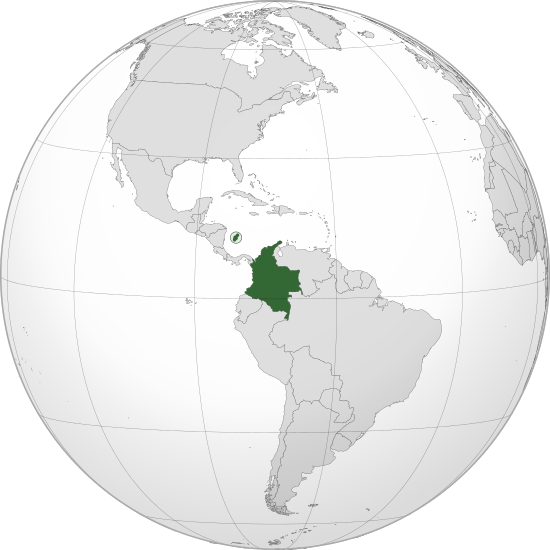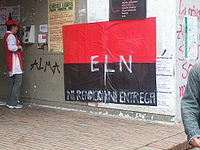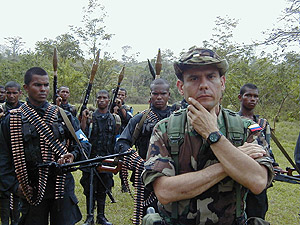Colombia

climate
Colombia lies in the northwest of South America bordered to the north by Panama, to the east by Venezuela and Brazil and to the south by Ecuador and Peru. Because it is located very close to the equator they have almost the same weather all around the year. They do have rain seasons, but nothing like winter, autumn or fall. However, many people in Colombia live in higher regions in the mountains where the average temerature is lower. For example the capital, Bogota lies in the Andes at about 2600 meters and has an average temerature of 13 degrees celsius, whereas cities at sea level have average temperatures around 25 degrees celsius.
geography
Colombia is a very beautiful country. North of it lies the caribbean sea with its famous azure blue water and white sand beaches. To the west lies the Pacific ocean. The Andes cross through the north-western part of colombia. In the center and east of colombia lies a huge plane called the "llanos" that also stretches into Venezuela. The southern part of Colombia is the Amazon rainforest region.

.jpg)


history
The territory of what is now Colombia used to be inhabited by various indigenous prople when in 1499 the Spanish arrived and colonized it. Colombia won the war of independance against Spain in 1819. What is now Colombia finally emerged in 1903.
Since the 1960s the country has suffered from an armed conflict between military, crime syndicates, guerillia and paramilitary groups. This conflict escalated in the 1990s but has decreased considerably since 2000.


The Colombian Conflict
The armed conflict in colombia has been going on for over 50 years now The reasons why the groups, participating in the fight started to form vary and can only be explained by looking at the history of Colombia. However, one important factor has always been the very unequal wealth distribution between rich and poor throughout Colombia's history. Ever since the colonisation of Colombia there have always neem some few people who had most of the wealth and power and were unwilling to share it. Moreover, corruption is a big problem in Colombia. The armed conflict that is still present today followed after "La Violencia", a ten year civil war from 1948 until 1958.
La Violencia
The starting point of La Violencia was the murder of a popular politician and presidenztial candidate from the Colombian Liberal Party. For the ten following years the members of the political parties at the time, the Colombian Conservative Party,the Colombian Liberal Party and the Colombian Communist Party, fought against each other in the rural country . Overall it is estimated that 200 000 people died in this conflict and millions fled the countryside to the safer cities. In the aftermath of this conflict some of the liberal and communist militants reorganized to form the "Revolutionary Armed Forces of Colombia" (FARC). The second guerillia group that formed in the 1960s was the "Ejercito de Liberacion Nacional"(ELN).
The FARC
The FARC is the largest guerillia group in Colombia and were established in 1964 after the colombian army attacked communist enclaves in rural parts of colombia. In the beginning their motives for fighting were political but over the centuries very little of their idealism has lasted. At some point they started to finance their war by producting and selling drugs and by kidnapping people and collecting ransom. A huge territory of the colombian state in the south-east, known as "zona roja", is controlled by them. There they encourage the farmers to plant coca. After the harvesting, the FARC buy the coca from the farmers and sell it to trafficers that smuggle it to the US, the EU and other countries.
.jpg)

The ELN
The ELN is smaller than the FARC and a bit less known. It was formed by a group of young students with communist ideals. In the beginning they followed the ideas of Che Guevara. One of their most known members was Camillo Torres Restrepo who worked at the UNAL and was one of the co-founders of the faculty of sociology in 1960. He was a Priest and before joining the ELN he was very involved in several student and political movements. After beeing persecuted he abandoned his position at the UNAL, joined the ELN and died soon afterwards. However, one should know that until today there are people at the UNAL that sympathise with the ideas of the ELN and will continue to do so as long as the political situation in Colombia does not change. However, similar to the FARC the ELNs motives changed over time and today most of their actions can be explained by an urge to maintain or gain more power. The picture with the ELN flag to the left of this text was taken on the UNAL campus.
The paramilitary forces
The foundation of paramilitary groups was supported by the Colombian and US government in the 1960s in order to fight against the communist guerillia groups. since then they became independant of the government and started to fight on their own. They now also have terretories under their control, and finance themselves through kidnapping and drugs. Their main enemys are the guerillia groups and there are suspicions that the colombian military has worked together with paramiliary groups occasionally, using them to do the dirty work for them. The paramilitary groups have commited many massacres and tortured people. When the paramilitary takes over a village that has been under the control of a guerillia group they often kill civilians who they think helped the guerillia groups. In 2003 after decades of civil war, most of the paramilitary groups have demobilized, given back their arms and are now living as normal colombians. There are special programs to educate and resocialize them.

current situation
The conflict was the most violent in the 1990s, when the FARC and the paramilitary groups were even starting to take over the second biggest city (Medellin) of colombia and people were being shot in the streets. In hindsight, the decision of president Uribe to increase the military funds improved the situation quite a bit. The paramilitary forces have given up their weapons and the FARC and the ELN seem to have lost influence and men over the last years. Moreover, the FARC is currently negotiating with the colombian government and the reported kidnappings have decreased significantly over the last decade. 10 years ago it was considered very dangerous to travel between cities by bus. Now it is quite safe. however the FARC still has an own terretory, which can not been taken away from them easily, because they have deployed many land mines.